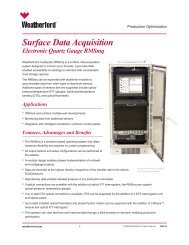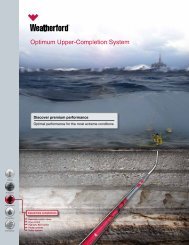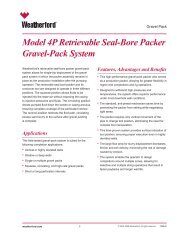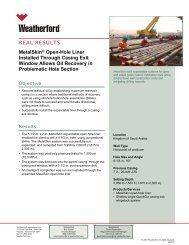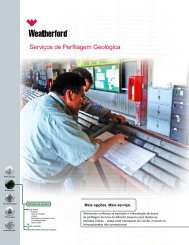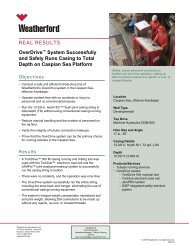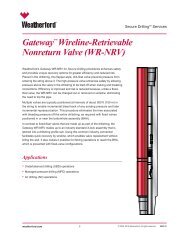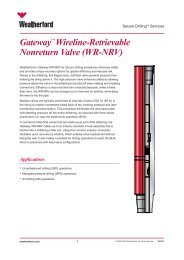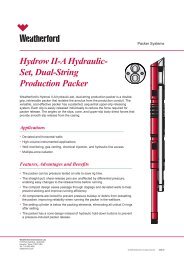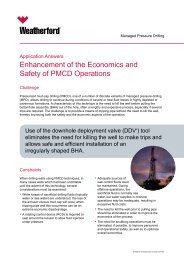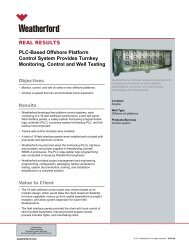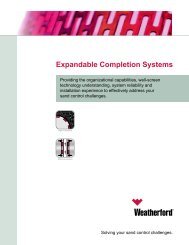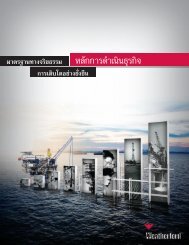Magazine - Weatherford International
Magazine - Weatherford International
Magazine - Weatherford International
- No tags were found...
Create successful ePaper yourself
Turn your PDF publications into a flip-book with our unique Google optimized e-Paper software.
Guy Feasey is an expat’s expatriate. His motheris English, his father a New Zealander, and hewas born in Quito, Ecuador. The family traveledextensively in South America, and when Feaseystarted at a boarding school in the United Kingdom,it was time to adjust to yet another new culture.On another continent, Feasey got his start in theoil patch in Bakersfield, California, USA, wherehe worked as a rig and diesel technician. This jobinspired him to get a degree, and so he entered NewZealand’s Otago University, which led to a job inKalgoorlie, Australia—in the gold mining business.Safe to say, Feasey has been around. And thatbackground perhaps explains how a geologist andformer gold miner found considerable successchampioning such projects as the SeaLance systemas <strong>Weatherford</strong>’s Global Strategic Business Managerfor Drilling with Casing. All those years adjustingand adapting to different cultures and perspectivesresulted in a uniquely suited individual for managingbig projects with lots of viewpoints.“You have to adapt and be diplomatic—traits manyexpats share,” observes Feasey.Colleague Scott Beattie, Global Business Unit Leader,Drilling with Casing, says, “Guy possesses a numberof <strong>Weatherford</strong>’s five core behaviors; however, humilityand intensity are at the top of the list.”Feasey says, “I love getting these projects off theground. Each one is different. You have to hit theground running and get on with it.”A case in point is the ongoing SeaLance project. Itwas envisioned in a conversation Feasey had yearsago in Sarawak, Malaysia. The concept was recentlyreinvigorated with new interest offshore Norway.Since then, deepwater drillers around the globe haveexpressed growing interest in the new SeaLancesystem. With phase one ready to roll out next year,phase two is already a hot topic of discussion.“There is much interest in the system and its variousapplications; and there are many new ideas forphase two,” says Feasey. “Now that clients havewind of it, we are getting lots of people askingquestions about it.“I’m right where I like to be—in the middle of it all.”Rethinking Casing DesignThe technology promises to be a multifaceted enablerfor drilling deepwater prospects.By managing gas and water flows, fluid losses, caverns,ledges, collapsed hole and rubble zones—to namea few—the system conserves casing points, helpingdeepwater wells reach TD with the optimal hole size.“This feature creates the opportunity to rethinkcasing designs so that hole diameter is conservedand contingency casing strings are saved for deeperproblems closer to the reservoir,” advises Beattie. “Italso leverages the capabilities of other hazard mitigationtechnologies deeper in the hole.”Lessening the need to fight shallow-hole problemsreduces NPT, lost-circulation materials, fluid systemsand other expenses. And the drilling-with-casingprocess generally achieves significant time and costssavings with combined drilling and casing operations.“Other benefits are being revealed,” notes Beattie.“Apparently vortex-induced vibrations—which can be aproblem when running large casing strings to depth—cease when the casing is rotated during drilling.”In Step with ClientsEarly development prospects for the SeaLance systemwere supported by more than 800 jobs and 10 yearsof <strong>Weatherford</strong> DwC deployments in land, platform andother surface applications. But subsea operations placesignificantly different demands on the technology.“We had the procedure,” says Beattie. “We knewgenerally what a subsea system had to accomplish. Andwe could draw from existing <strong>Weatherford</strong> technology tosuggest how that system might be developed. But weknew it was going to take a lot of engineering resourcesto produce the real thing.”The process began with brainstorming by the <strong>Weatherford</strong>team and consultation with ENI to pull the concept together.Continued collaboration and a significant investment inresearch and development greatly matured the design andbrought it to the point of creating a prototype.“ENI has been very open through the process,”observes Beattie. “Their knowledge and assistance hasmade this design process much easier.”october 2009 9



